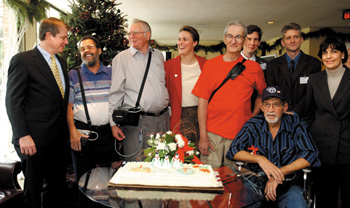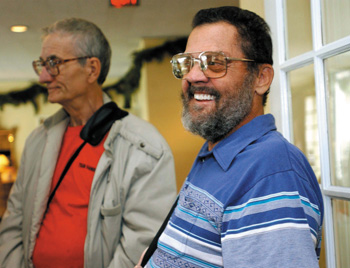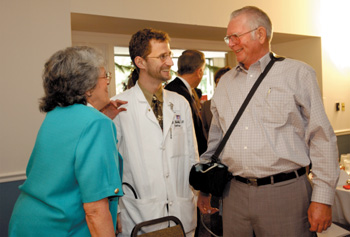
Dr. Richard Norris Pierson III, LVAS patients Dick Riley and Jack Fawbush, Renee Howser, heart transplant coordinator, patient Charles Armitage, Rick Scott, LVAS senior operator, patient Lynn Glover, Allen Dyer, LVAS senior operator, and Dr. Stacy Davis gather at a reunion at Vanderbilt's University Club Wednesday. (photo by Dana Johnson)
LVAS patients value time at first reunion

LVAS patients Charles Armitage, left, and Cyril Riley gather at the reunion for several LVAS patients. (photo by Dana Johnson)

Norma and Jack Fawbush talk with Dr. Don Chomsky at the reunion. Chomsky was Fawbush's doctor after he received the LVAS. (photo by Dana Johnson)
Usually when a group gathers for a reunion, it’s hard to hear from all the chatter.
But for a group of LVAS (left ventricular assist system) patients from Vanderbilt—it’s not just the lively conversation filling the room. Rather it’sthe loud, hollow clicking sound from the five patients who for the first time met Wednesday to talk about the device that saved their lives.
“Novacor Music” is what patients and medical staff refer to the sound of the LVAS pumping blood through the heart. It’s the opening and closing of the mechanical plates that push blood through the device.
Vanderbilt’s first LVAD (left ventricular assist device) was implanted in 1986 as a bridge to transplant. The implantable circulatory system, a mechanical device that pumps blood through the heart, is used in cardiac transplant patients at risk of imminent death from left ventricular failure. Then patients were hospitalized with the device until a heart became available and patients would often need assistance pushing the nearly 50-pound LVAD on coasters.
Now, 15 years later, the portable LVAS allows healthy patients to leave the hospital while awaiting transplants. It is also used for patients who are not transplant candidates as a destination therapy.
Marketed by World Heart Corporation, the Novacor® LVAS has been implanted into nine patients since 2000.
Although it took some convincing, Jack Fawbush had the device implanted in July. He credits the system with allowing him to live again.
“I couldn’t do anything,” Fawbush said of his activity level prior to the surgery. “I have a little farm, and I haven’t been to that barn in probably close to a year. Now, I go to the barn two to three times a day. I drive my tractor. I built a fence, with some help, and I’m restoring an old John Deere tractor in my garage.
“I can do everything I want to do,” Fawbush said.
The 67-year-old admits that he initially did not want “any part” of the new technology. But after Dr. Richard Pierson, associate professor of Surgery in Cardiac and Thoracic Surgery, had a one-on-one conversation with him, he changed his mind.
“I just thought surely there was something else they could do,” Fawbush recalled. “Dr. Pierson came in, sat down on my bed and told me I had three options. He told me he could send me home with IV medications, have nurses come by to check on me and I’d live about four months. I thought that wasn’t too good.
“Or he said I could stay in the hospital for my care, and I’d live about four months. I thought again, my options really aren’t getting any better. Then he told me they could give me an LVAS and my health would improve.”
Fawbush took the afternoon to think it over and decided he wanted to live.
He is one of five destination therapy patients enrolled in a Vanderbilt trial to explore how long the LVAS can safely be used in patients who are not transplant candidates.
Traditionally the device is used for patients as a bridge to heart transplant. Vanderbilt has performed a total of 36 surgeries since 1986, nine using the World Heart Corporation’s Novacor portable device.
The gathering of LVAS recipients brought many smiles to patients, families and the medical staff.
“There is no better example of the gift of life than what is represented by the people sitting in this room,” said Pierson, principal investigator of the trial. “With a left ventricular assist system, patients often become healthier, suffer far fewer complications and most importantly, can live longer, with a high quality.”
Dr. Stacy Davis, assistant professor of Medicine and medical director of Vanderbilt Heart Transplant Program, said it was exciting to see the five patients all together in one place.
“I remember when I was a resident at Stanford and the devices were bigger than this lectern,” Davis said referring to the compact size of the newest device. “This path is only the beginning. Who knows what the future will bring.”
This use of the LVAS is a new indication for this device that was previously used only for temporary support of the heart until a donor heart became available for transplant. Ultimately, doctors see this device as a tangible alternative to transplant, which may serve as a permanent therapy for some.
“There are a lot of projects and efforts we make at this institution,” said Dr. Wright Pinson, H. William Scott Professor of Surgery. “But rarely do we see a day like this that is so pointed. I really want to make it clear to you that if you ever wanted to see what history looks like, here it is. This technology is a very important and historical step.”
Brenda Harris, the longest living Novacor LVAS device recipient, was not able to attend the gathering. She is recovering from a repair of her device, which she received in July 2000.
The device has given her a chance to continue living, she said.
“I was in complete heart failure,” Harris said. “I had not worked since 1986. But since having the device, I get around better and can do most anything.
“I know that had I not received this device, I would be dead. It has changed my life.”
That’s something Dr. Peer M. Portner, developer of the device and a consulting professor of Cardiothoracic Surgery at the Stanford University School of Medicine, loves to hear.
“It’s extraordinary to see so many Novacor recipients in one place,” Portner said. “I’ve never see that before. This is quite remarkable. I’m always pleased to see their faces and hear about the impact the device has had on their lives.
“I love a technical challenge, but the humanitarian aspect was important. The ability to save lives and provide a good quality of life – that’s extraordinary.”













